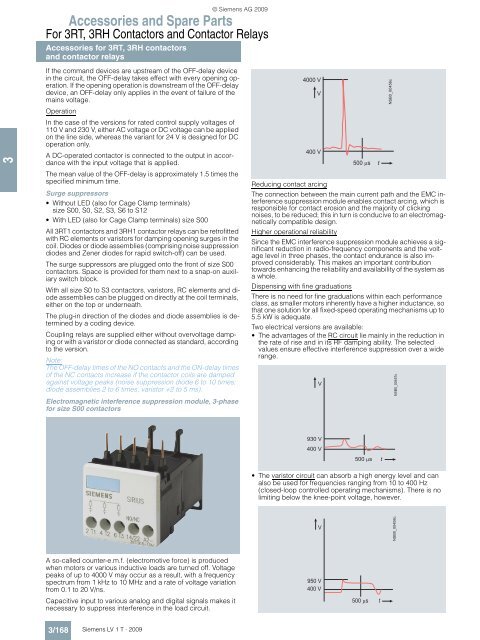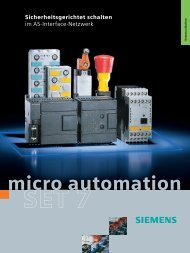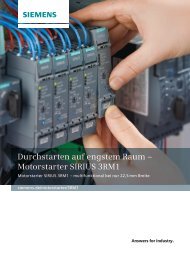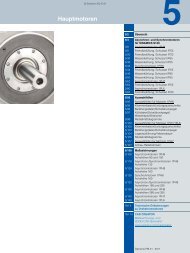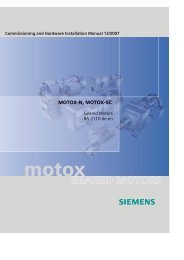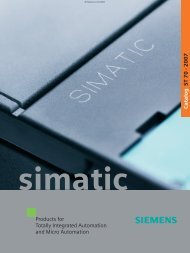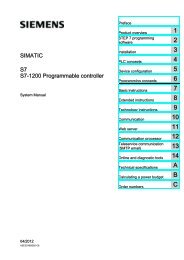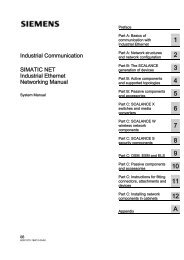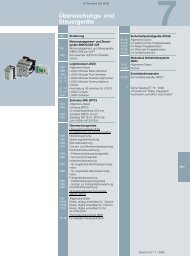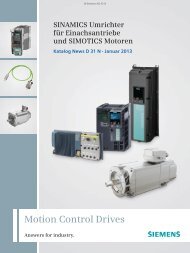Catalog LV1 T 2009 Chapter 3 EN
Catalog LV1 T 2009 Chapter 3 EN
Catalog LV1 T 2009 Chapter 3 EN
Create successful ePaper yourself
Turn your PDF publications into a flip-book with our unique Google optimized e-Paper software.
3<br />
Accessories and Spare Parts<br />
For 3RT, 3RH Contactors and Contactor Relays<br />
Accessories for 3RT, 3RH contactors<br />
and contactor relays<br />
If the command devices are upstream of the OFF-delay device<br />
in the circuit, the OFF-delay takes effect with every opening operation.<br />
If the opening operation is downstream of the OFF-delay<br />
device, an OFF-delay only applies in the event of failure of the<br />
mains voltage.<br />
Operation<br />
In the case of the versions for rated control supply voltages of<br />
110 V and 230 V, either AC voltage or DC voltage can be applied<br />
on the line side, whereas the variant for 24 V is designed for DC<br />
operation only.<br />
A DC-operated contactor is connected to the output in accordance<br />
with the input voltage that is applied.<br />
The mean value of the OFF-delay is approximately 1.5 times the<br />
specified minimum time.<br />
Surge suppressors<br />
Without LED (also for Cage Clamp terminals)<br />
size S00, S0, S2, S3, S6 to S12<br />
With LED (also for Cage Clamp terminals) size S00<br />
All 3RT1 contactors and 3RH1 contactor relays can be retrofitted<br />
with RC elements or varistors for damping opening surges in the<br />
coil. Diodes or diode assemblies (comprising noise suppression<br />
diodes and Zener diodes for rapid switch-off) can be used.<br />
The surge suppressors are plugged onto the front of size S00<br />
contactors. Space is provided for them next to a snap-on auxiliary<br />
switch block.<br />
With all size S0 to S3 contactors, varistors, RC elements and diode<br />
assemblies can be plugged on directly at the coil terminals,<br />
either on the top or underneath.<br />
The plug-in direction of the diodes and diode assemblies is determined<br />
by a coding device.<br />
Coupling relays are supplied either without overvoltage damping<br />
or with a varistor or diode connected as standard, according<br />
to the version.<br />
Note:<br />
The OFF-delay times of the NO contacts and the ON-delay times<br />
of the NC contacts increase if the contactor coils are damped<br />
against voltage peaks (noise suppression diode 6 to 10 times;<br />
diode assemblies 2 to 6 times, varistor +2 to 5 ms).<br />
Electromagnetic interference suppression module, 3-phase<br />
for size S00 contactors<br />
A so-called counter-e.m.f. (electromotive force) is produced<br />
when motors or various inductive loads are turned off. Voltage<br />
peaks of up to 4000 V may occur as a result, with a frequency<br />
spectrum from 1 kHz to 10 MHz and a rate of voltage variation<br />
from 0.1 to 20 V/ns.<br />
Capacitive input to various analog and digital signals makes it<br />
necessary to suppress interference in the load circuit.<br />
3/168<br />
Siemens LV 1 T · <strong>2009</strong><br />
© Siemens AG <strong>2009</strong><br />
4000 V<br />
V<br />
400 V<br />
500 ms<br />
Reducing contact arcing<br />
The connection between the main current path and the EMC interference<br />
suppression module enables contact arcing, which is<br />
responsible for contact erosion and the majority of clicking<br />
noises, to be reduced; this in turn is conducive to an electromagnetically<br />
compatible design.<br />
Higher operational reliability<br />
Since the EMC interference suppression module achieves a significant<br />
reduction in radio-frequency components and the voltage<br />
level in three phases, the contact endurance is also improved<br />
considerably. This makes an important contribution<br />
towards enhancing the reliability and availability of the system as<br />
a whole.<br />
Dispensing with fine graduations<br />
There is no need for fine graduations within each performance<br />
class, as smaller motors inherently have a higher inductance, so<br />
that one solution for all fixed-speed operating mechanisms up to<br />
5.5 kW is adequate.<br />
Two electrical versions are available:<br />
The advantages of the RC circuit lie mainly in the reduction in<br />
the rate of rise and in its RF damping ability. The selected<br />
values ensure effective interference suppression over a wide<br />
range.<br />
V<br />
930 V<br />
400 V<br />
500 ms<br />
The varistor circuit can absorb a high energy level and can<br />
also be used for frequencies ranging from 10 to 400 Hz<br />
(closed-loop controlled operating mechanisms). There is no<br />
limiting below the knee-point voltage, however.<br />
V<br />
950 V<br />
400 V<br />
500 ms<br />
t<br />
t<br />
t<br />
NSB0_00456c<br />
NSB0_00457c<br />
NSB0_00458c


